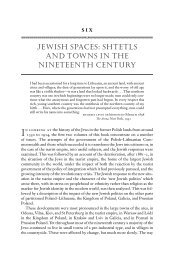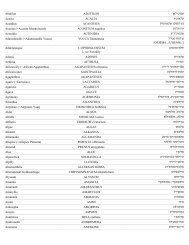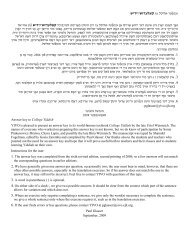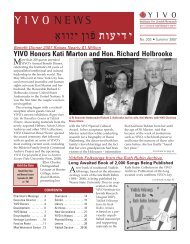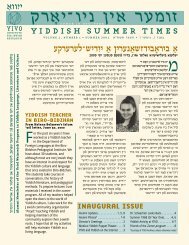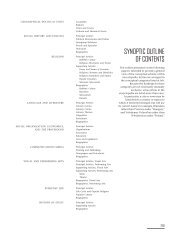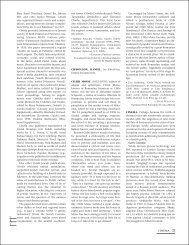t any plant names in Yiddish - YIVO Institute for Jewish Research
t any plant names in Yiddish - YIVO Institute for Jewish Research
t any plant names in Yiddish - YIVO Institute for Jewish Research
Create successful ePaper yourself
Turn your PDF publications into a flip-book with our unique Google optimized e-Paper software.
XXII<br />
˘È„”È Ôȇ ËÏÚÂÂ≠ÔÒ˜ÈÂÂÚ‚ È„ Ÿ ¯ÚËÎÚ˘ È΄¯Ó<br />
terms of numbers, especially s<strong>in</strong>ce its leadership was arrested<br />
and shot dur<strong>in</strong>g the Stal<strong>in</strong> purges of the 1930s, but it did capture<br />
the imag<strong>in</strong>ation of quite a number of people. It enriched the<br />
<strong>Yiddish</strong> language with dozens of Far Eastern <strong>plant</strong> <strong>names</strong>, hitherto<br />
unknown to the <strong>Yiddish</strong> speech community: mandzhúrisher<br />
áshboym (Frax<strong>in</strong>us mandzhurica), mandzhúrisher líndnboym<br />
(Tilia mandzhurica), mandzhúrisher nísnboym (Juglans mandzhurica),<br />
mandzhúrisher kanátnik (Abutilon theophrasti), mongólisher<br />
demb (Quercus mongolica), koréer límene-yágde (Schisandra<br />
koraiensis), koréishe sósne (P<strong>in</strong>us koraiensis), daúrer róytboym<br />
(Larix gmel<strong>in</strong>i), daúrer b(e)réze (Betula dahurica), daúrishe lílye<br />
(Lillium dauricum), daúrishe royz (Rosa davurica). 9 These terms<br />
are commonly used <strong>in</strong> the works of <strong>Yiddish</strong> writers and poets<br />
who made Birobidzhan their home permanently or <strong>for</strong> a long period<br />
(Emonuel Kazakevitsh, Henekh Kazakevitsh, Buzi Miler, A.<br />
Vergelis), as well as those who came only <strong>for</strong> a short time but<br />
who wrote about it (D. Bergelson <strong>in</strong> his novel Birebidzhaner, M.<br />
Khashtshevatski's A rayze keyn Birebidzhan, Motl Grubian's "A<br />
vokh <strong>in</strong> Birebidzhan" <strong>in</strong> Sovetish heymland).<br />
m. When a large <strong>Jewish</strong> community arose <strong>in</strong> Florida after World<br />
War II, a number of subtropical <strong>plant</strong>s, especially flowers, started<br />
cropp<strong>in</strong>g up <strong>in</strong> the works of <strong>Yiddish</strong> poets who had settled<br />
there, notably Pesye Hershfeld-Pomerants-Honigboym. The<br />
same is true of Cali<strong>for</strong>nia. When describ<strong>in</strong>g their physical environment,<br />
the Cali<strong>for</strong>nia writers (Ronch, Dayksl, etc.), however,<br />
too often simply used English loan words, although some l<strong>in</strong>guistic<br />
creativity was also at work <strong>in</strong> the <strong>for</strong>m of calques: Yehoyshúe-boym<br />
'Joshua tree' (Yucca brevifolia).<br />
n. In present-day Israeli <strong>Yiddish</strong> a number of Modern Hebrew botanical<br />
terms have found their way <strong>in</strong>to the writ<strong>in</strong>gs of Israeli<br />
<strong>Yiddish</strong> writers: tiltán (<strong>for</strong> example, <strong>in</strong> the writ<strong>in</strong>gs of Avrom Lev,<br />
a farmer-poet), khatsáv (<strong>in</strong> the writ<strong>in</strong>gs of Yankev-Tsvi Shargel).<br />
o. Beg<strong>in</strong>n<strong>in</strong>g <strong>in</strong> the second half of the 19th century, but especially<br />
after World War I, down to this day, conscious <strong>in</strong>novation has prevailed:<br />
m<strong>any</strong> <strong>plant</strong> <strong>names</strong> have been co<strong>in</strong>ed, either because the older<br />
<strong>names</strong> have been <strong>for</strong>gotten or become obsolete, or because<br />
lexical gaps had to be filled. This was done to a large extent at<br />
the Kiev <strong>Institute</strong> <strong>for</strong> <strong>Jewish</strong> Proletarian Culture, <strong>in</strong> the 1930s.<br />
<strong>Yiddish</strong> agricultural term<strong>in</strong>ology<br />
<strong>Yiddish</strong> agriculture? Weren't Eastern European Jews either scholars<br />
9) The vacillation between dahur…/daur…/davur… is <strong>in</strong> the <strong>in</strong>ternational scientific term<strong>in</strong>ology,<br />
not of our mak<strong>in</strong>g.



